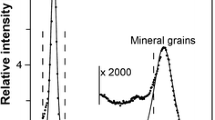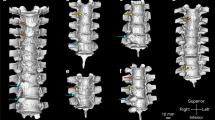Abstract
Degeneration of the intervertebral disc, seen radiologically as loss of disc height, is often associated with apparent remodelling in the adjacent vertebral body. In contrast, maintenance or apparent increase in disc height is a common finding in osteoporosis, suggesting the properties of the intervertebral disc may be dependent on those of the vertebral body or vice versa. We have investigated this relationship by measuring the radiological thickness of the subchondral bone and comparing it to the chemical composition of the adjacent disc. Sagittal slabs were sampled from lumbar spines obtained at autopsy and X-rayed microfocally. The thickness of the subchondral bone was measured and correlated with the composition of the adjacent intervertebral disc. Eighty-three cadaveric endplates were studied from individuals aged 17–85 years. There was regional variation in thickness of the subchondral bone, being greater adjacent to the annulus than the nucleus, and the endplates cranial to the disc were thicker than those caudal. There was a positive correlation between the thickness of the subchondral bone and the proteoglycan content of the adjacent disc, particularly in the region of the nucleus. A weaker correlation was seen here between water content and thickness, whilst there was no significant correlation at the annulus or between the bone thickness and collagen content. The positive relationship between the radiographic thickness of vertebral subchondral bone and the proteoglycan content of the adjacent disc seen in human cadaveric material could be due to the bone responding to a greater hydrostatic pressure being exerted by discs with higher proteoglycan content than by those with less proteoglycan present. It is suggested that while this is true in “normal” specimens, the relationship becomes altered in disease states, possibly because of changes to the nutritional pathway of the disc, with resultant endplate-bone remodelling affecting the flow of solutes to and from the intervertebral disc.
Similar content being viewed by others
References
Bell GR, Modic MT (1992) Radiology of the lumbar spine. In: Rothman RH, Simeone FA (eds) The spine. Saunders, Philadelphia, pp 125–153
Britton JM, Davie MWJ (1990). Mechanical properties of bone from iliac crest and relationship to L5 vertebral bone. Bone 11:21–28
Chalmers J, Weaver JK (1963) Cancellous bone: its strength and changes with aging and an evaluation of some methods for measuring its mineral content. J Bone Joint Surg [Am] 48:299–308
Farndale RW, Buttle DJ, Barrett AJ (1986) Improved quantitation and discrimination of sulphated glycosaminoglycans by use of dimethylmethylene blue. Biochim Biophys Acta 883:173–177
Garfin F, Rydevik BL, Lipson SJ (1992) Spinal stenosis. In: Rothman RH, Simeone FA (eds) The spine. Saunders, Philadelphia, pp 791–826
Grant RA (1964) Estimation of hydroxyproline by the AutoAnalyser. Clin Pathol 17:685–686
Grieve GP (1988) In: Common vertebral joint problems, 2nd edn. Churchill Livingstone, Edinburgh, p 401
Haddaway MJ, Davie MWJ, McCall IW (1992) Bone mineral density in normal women and reproducibility of measurements in spine and hip using dual-energy X-ray absorptiometry. Br J Radiol 65:213–217
Hansson T, Roos B (1981) The relation between bone mineral content, experimental compression fractures, and disc degeneration in lumbar vertebrae. Spine 6:147–153
Hays WL (1988) Statistics. Holt, Rinehart and Winston, Fort Worth
Keller TS, Hansson TH, Abram AC, Spengler DM, Panjabi MM (1988) Regional variations in the compressive properties of lumbar vertebral trabeculae. Effects of degeneration. Spine 14:1012–1019
Keller TS, Ziv I, Moeljanto E, Spengler DM (1993) Interdependence of lumbar disc and subdiscal bone properties: a report of the normal and degenerative spine. J Spinal Disord 6:106–113
Kurowski P, Kubo A (1986) The relationship of degeneration of the intervertebral disc to mechanical loading conditions on lumbar vertebrae. Spine 11:726–731
McNally DS, Adams MA (1992) Internal intervertebral disc mechanics as revealed by stress profilometry. Spine 17:66–73
Modic MT, Masaryk TJ, Ross JS, Carter JR (1988) Imaging of degenerative disk disease. Radiology 168:177–186
Resnick D (1985) Degenerative diseases of the vertebral column. Radiology 156:3–14
Resnick D, Niwayama G. (1981) Degenerative disease of the spine. In: Resnick D, Niwayama G (eds) Diagnosis of bone and joint disorder. Saunders, Philadelphia, pp 1368–1415
Roberts S, Beard HK, O'Brien JP (1982) Biochemical changes of intervertebral discs in patients with spondylolisthesis or with tears of the posterior annulus fibrosus. Ann Rheum Dis 41: 78–85
Roberts S, Menage J, Urban JPG (1989) Biochemical and structural properties of the cartilage endplate and its relation to the inter-vertebral disc. Spine 14:166–174
Schiebler ML, Camerino VJ, Fallon MD, Zlatkin MB, Grenier N, Kressel HY (1991) In vivo and ex vivo magnetic resonance imaging evaluation of early disc degeneration with histopathologic correlation. Spine 16:635–640
Sether LA, Nguyen C, Yu S, et al (1990) Canine intervertebral disks: Correlation of anatomy and MR imaging. Radiology 175:207–211
Stairmand JW, Holm S, Urban JPG (1991) Factors influencing oxygen concentration gradients in the intervertebral disc: a theoretical analysis. Spine 16, 444–449
Urban JPG, McMullin JF (1988) Swelling pressure of the lumbar intervertebral discs: effect of age, spinal level, composition and degeneration. Spine 13:179–187
Urban JPG, Holm S, Maroudas A, Nachemson A (1977) Nutrition of the intervertebral disc. An in vivo study of solute transport. Clin Orthop 129:101–114
Vanharanta H, Sachs BL, Spivey M, et al (1988) A comparison of CT/discography, pain response and radiographic disc height. Spine 13:321–324
Venn MF (1979) Chemical composition of human femoral head cartilage: influence of topographical position and fibrillation. Ann Rheum Dis 38:57–62
White MJ, Jenkins JR (1991) Pathologic compression in spinal malignancy secondary to intervertebral disk expansion. Comp Med Imaging Graphics 15:373–377
Ziran BH, Pineda S, Pokharna H, Esteki A, Mansour JM, Moskowitz RW (1994) Biomechanical, radiologic, and histopathologic correlations in the pathogenesis of experimental intervertebral disc disease. Spine 19:2159–2163
Author information
Authors and Affiliations
Rights and permissions
About this article
Cite this article
Roberts, S., McCall, I.W., Menage, J. et al. Does the thickness of the vertebral subchondral bone reflect the composition of the intervertebral disc?. Eur Spine J 6, 385–389 (1997). https://doi.org/10.1007/BF01834064
Received:
Revised:
Accepted:
Issue Date:
DOI: https://doi.org/10.1007/BF01834064




